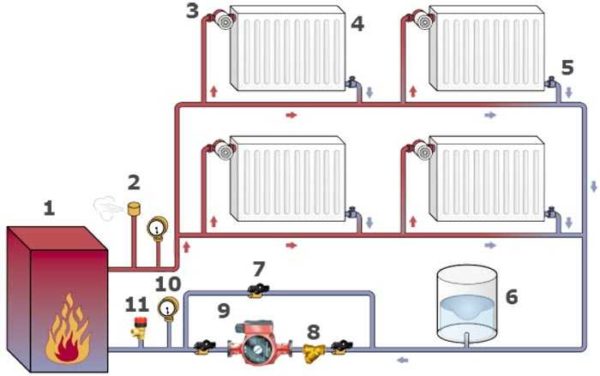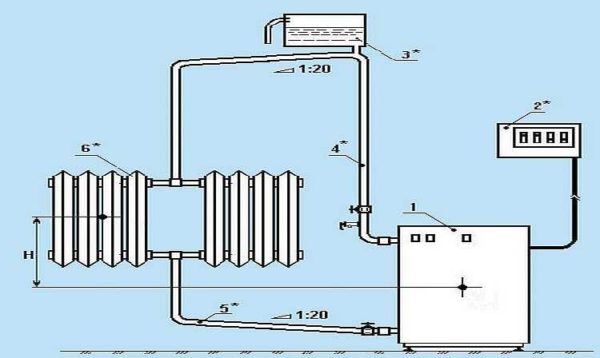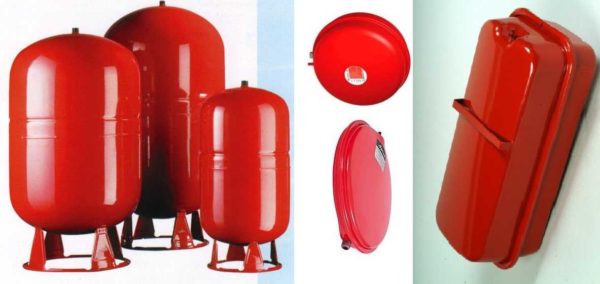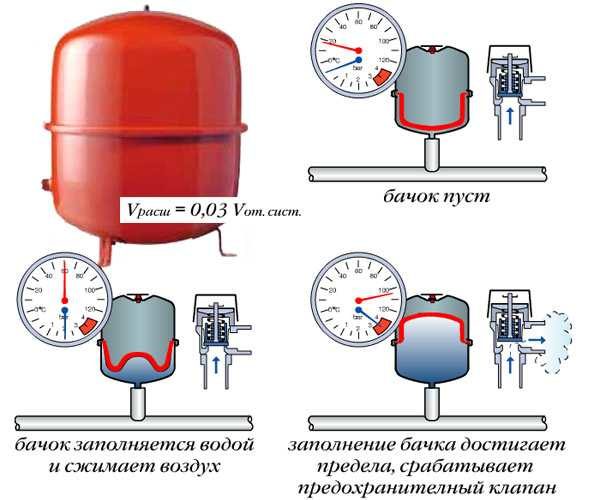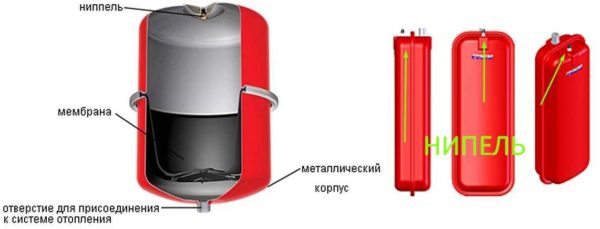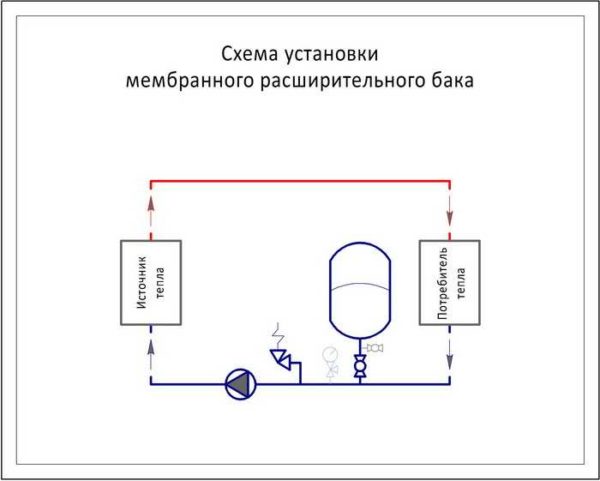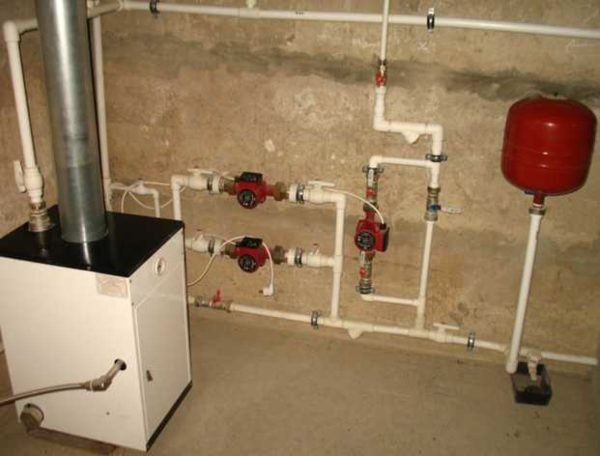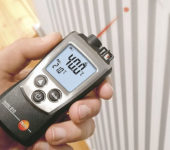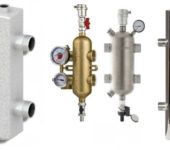Expansion tank for heating systems
Heating is a key life support system for a private house and its stable operation is very important. One of the parameters to be monitored is pressure. If it is too low, the boiler will not work; if it is too low, the equipment will wear out too quickly. To stabilize the pressure in the system, an expansion tank for heating is required. The device is simple, but without it, the heating will not work for a long time.
The content of the article
What is an expansion tank for heating for?
When the heating system is operating, the coolant often changes its temperature - it heats up, then cools down. Understandably, the volume of the liquid changes. It increases and decreases. Excess coolant is just displaced into the expansion tank. So the purpose of this device is to compensate for changes in the volume of the coolant.
Types and device
There are two hot water heating systems - open and closed. In a closed system, the circulation of the coolant is provided by a circulation pump. It does not create additional pressure, it just pushes water at a given speed through the pipes. In such a heating system, there is an expansion tank for closed-type heating. It is called closed because it is a sealed container, which is divided into two parts by an elastic membrane. In one part there is air, in the other the excess coolant is displaced. Due to the presence of a membrane, the tank is also called a membrane one.
An open heating system does not provide for a circulation pump. In this case, an expansion tank for heating is just any container - even a bucket - to which heating pipes are connected. It doesn't even need a cover, although it might be.
In the simplest version, this is a container welded from metal, which is installed in the attic. This option has a significant drawback. Since the tank is leaking, the coolant evaporates and it is necessary to monitor its amount - to top up all the time. You can do this manually - from a bucket. This is not very convenient - there is a risk of forgetting to replenish water supplies. This threatens the system with airing, which can lead to its breakdown.
Automated water level control is more convenient. True, then in the attic, in addition to the heating pipes, you will also have to pull the water supply and also take the overflow hose (pipe) somewhere in case the tank is overfilled. But there is no need to regularly check the amount of coolant.
Volume calculation
There is a very simple method for determining the volume of the expansion tank for heating: 10% of the volume of the coolant in the system is calculated. You had to calculate it when developing the project. If these data are not available, you can determine the volume empirically - drain the coolant, and then fill in a new one, while measuring it (put it through the meter). The second way is to calculate. Define pipe volume in the system, add the volume of the radiators. This will be the volume of the heating system. Here we find 10% of this figure.
Formula
The second way to determine the volume of the expansion tank for heating is to calculate it using the formula. Here, too, the volume of the system will be required (indicated by the letter C), but other data will also be needed:
- maximum pressure Pmax at which the system can operate (usually the maximum boiler pressure is taken);
- initial pressure Pmin - from which the system starts operation (this is the pressure in the expansion tank, indicated in the passport);
- coefficient of expansion of the heat carrier E (for water 0.04 or 0.05, for antifreeze it is indicated on the label, but usually in the range of 0.1-0.13);
Having all these values, we calculate the exact volume of the expansion tank for the heating system using the formula:
The calculations are not very complicated, but is it worth messing around with them? If the system is open, the answer is unambiguous - no. The cost of the container does not depend very much on the volume, plus everything you can do it yourself.
Expansion tanks for closed-type heating are worth counting. Their price depends on the volume. But, in this case, it is still better to take with a margin, since insufficient volume leads to rapid wear of the system or even to its failure.
If the boiler has an expansion tank, but its capacity is not enough for your system, put a second one. In total, they should give the required volume (the installation is no different).
What will the insufficient volume of the expansion tank lead to?
When heated, the coolant expands, its excess ends up in the expansion tank for heating. If all the surplus does not fit, it is vented through the emergency pressure relief valve. That is, the coolant goes down the drain.
Then, when the temperature drops, the volume of the coolant decreases. But since there is already less of it in the system than it was, the pressure in the system drops. If the lack of volume is insignificant, such a decrease may not be critical, but if it is too small, the boiler may not work. This equipment has a lower pressure limit at which it will operate. When the lower limit is reached, the equipment is blocked. If you are at home at this time, you can remedy the situation by adding a coolant. If you are not there, the system may unfreeze. By the way, working at the limit also does not lead to anything good - the equipment quickly breaks down. Therefore, it is better to play it safe a little and take a slightly larger volume.
Tank pressure
In some boilers (usually gas ones), the passport indicates what pressure must be set on the expander. If there is no such record, for the normal operation of the system, the pressure in the tank should be 0.2-0.3 atm lower than the operating pressure.
The heating system of a low private house usually operates at 1.5-1.8 atm. Accordingly, the tank should be 1.2-1.6 atm. The pressure is measured with a conventional manometer, which is connected to the nipple, which is located at the top of the tank. The nipple is hidden under a plastic cover, you unscrew it, you get access to the spool. Excess pressure can also be relieved through it. The principle of operation is the same as that of an automobile spool - bend the plate with something thin, releasing air to the required values.
You can also increase the pressure in the expansion vessel. This will require a car pump with a pressure gauge. Connect it to the nipple, pump it up to the required readings.
All of the above procedures are carried out with the tank disconnected from the system. If it is already installed, you do not need to remove it. You can check the pressure in the expansion vessel of the heating system on site. Just be careful! It is necessary to check and adjust the pressure in the expansion tank for heating when the system is not working and the coolant is drained from the boiler. For the accuracy of measurements and setting the tank, it is important that the pressure on the boiler is zero. Therefore, we drain the water carefully. Then we connect the pump with a pressure gauge and adjust the parameters.
Where to put in the system
An expansion vessel in a closed system is placed after the boiler before the pump, that is, so that it creates a flow in the opposite direction. This makes the system more reliable. So the specific installation location depends on where you have the circulation pump.
It is connected to the system through a tee. You cut a tee into the pipe, direct the perpendicular outlet upwards, the tank is screwed onto it. If the wall does not allow the container to be placed, you will have to make a knee, but the tank is turned up. Now we can assume that the expansion vessel is installed.
But for the convenience of checking, it is advisable to put another tee after the tank, on the free outlet of which a shut-off valve is installed. This makes it possible to check the membrane tank without draining the entire system - it cuts off the tank. Shut off the tap, bleed water from the boiler. Check the pressure on the disconnected branch (in the boiler). It should be zero. After that, you can carry out all the other work on setting.


